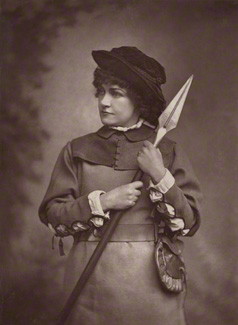
Charles Kemble was a Welsh actor of a prominent theatre family.
The Old American Company was an American theatre company. It was the first fully professional theatre company to perform in North America. It also played a vital role in the theatre history of Jamaica. It was founded in 1752 and disbanded in 1805. It was known as the Hallam Company (1752–1758), the American Company (1758–1785) and the Old American Company (1785–1805). With a few temporary exceptions, the Company enjoyed a de facto monopoly of professional theatre in the United States until 1790.
The Beaux' Stratagem is a comedy by George Farquhar, first produced at the Theatre Royal, now the site of Her Majesty's Theatre, in the Haymarket, London, on March 8, 1707. In the play, Archer and Aimwell, two young gentlemen who have fallen on hard times, plan to travel through small towns, entrap young heiresses, steal their money and move on. In the first town, Lichfield, they set their sights on Dorinda. Aimwell falls truly in love, and comedy ensues. Foigard, a priest and chaplain to the French officer, is actually an Irish priest called MacShane.

John Street Theatre, situated at 15–21 John Street, sometimes called "The Birthplace of American Theatre", was the first permanent theatre in the Financial District of Manhattan, New York. It opened on December 7, 1767, and was operated for several decades by the American Company. It closed on January 13, 1798.

Richard Wroughton (1748–1822), was an actor, who worked mainly in Covent Garden and Drury Lane, and occasionally in the city of his birth, Bath.

Francis Godolphin Waldron (1744–1818) was an English writer and actor, known also as an editor and bookseller.

Louisa, Countess of Craven, originally Louisa Brunton (1782–1860), was an English actress.

Thomas Harris was an English theatre manager, who became proprietor of Covent Garden Theatre.

John Hodgkinson was a well-known actor in the United States in the late 18th and early 19th century. He was born in England and came to the United States in 1792. William Dunlap and Hodgkinson managed the John Street Theatre together for a few years in the 1790s.

Maria Rebecca Davison (1780?–1858) was a British stage actress. She was billed as Miss Duncan in the early years of her career before her marriage. She appeared as a leading performer at the London patent theatres Covent Garden, the Haymarket Theatre and particularly at Drury Lane.

Marie Litton was the stage name of Mary Jessie Lowe, an English actress and theatre manager. After beginning a stage career in 1868, Litton became an actor-manager in 1871, producing plays for four years at the Court Theatre, including several by W. S. Gilbert. She also appeared in, and sometimes managed, other West End theatres. In the late 1870s, Litton managed the theatre at the Royal Aquarium, where she had some of her biggest acting successes, including as Lady Teazle in The School for Scandal (1877), Lydia Languish in The Rivals (1878), Miss Hardcastle in She Stoops to Conquer and Rosalind in As You Like It.
Stephen Woolls (1729-1799) was an American actor and singer, and member of the American and Old American Company.
Maria Henry née Storer, was an American stage actress. She was engaged in the Old American Company.
Sarah Hamilton was an Irish stage actress and singer of the eighteenth century.

Frances Brett Hodgkinson (1771–1803) was an English-born American theater actress. She played major roles in high comedy and tragedy plays and was also a noted performer of opera. She was the second wife of John Hodgkinson, a famous American stage actor.

Henry Howe was an English actor, appearing in prominent roles at London theatres. He was a member of the company at the Haymarket Theatre for forty years.
Laurence Clinch was an Irish actor, familiarly known as Larry, and accomplished in both tragedy and comedy. The popular farce St Patrick's Day was written and performed to showcase his particular talent.

Ralph Wewitzer (1748–1825) was an English actor. He won critical acclaim in supporting parts, but was never given leading roles. He had a 44-year acting career, and is thought to have learned over 400 speaking parts.
Montague Talbot (1774–1831) was an Irish stage actor and theatre manager.

Robert Benson (1765–1796) was an English stage actor of the eighteenth century. The son of two actors, he made his first London appearance at the Theatre Royal, Haymarket in 1778 as a child actor playing the Duke of York in Richard III and acted occasionally at the Theatre Royal, Drury Lane over the following years. After an absence of some time, he returned to Drury Lane in November 1786 having now graduated to adult roles. He became a reliable member of the company known for his character roles as comic eccentrics and smooth young gentleman. For the summer of 1791 he took over the management of Richmond Theatre with James Thompson and William Macready. He also acted at Haymarket during the summers and authored an operatic farce Britain's Glory which premiered there in 1795. In 1783 he married the actress Susanna Satchell (1758–1814), the sister of Elizabeth Satchell.













